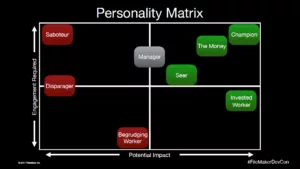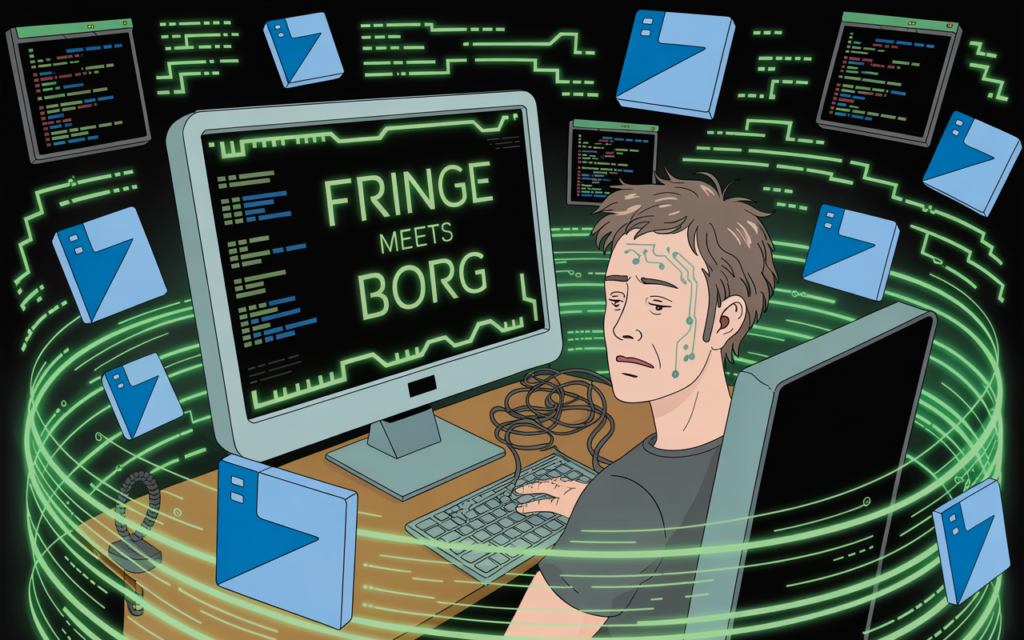A Detailed Presentation by Jonathan Stark at FMDiSC, May 13, 2023
Menu
- Introduction: Jonathan Stark’s Journey
- The Changing Landscape of Technology
- Eureka Moments: Key Career Turning Points
- Career Transitions: Overlapping Roles and Challenges
- Why Reinvention is Uncomfortable Yet Necessary
- How to Know When to Make a Change
- How to Identify the Right Change
- Value Creation: The Secret to Staying Relevant
- The Difference Between Expertise and Value
- The Challenges of Profitability and the Role of Value-Based Pricing
- Breaking the Cycle of Hourly Billing
- Overcoming Obstacles in Value-Based Pricing
- Practical Takeaways on Managing Scope and Client Expectations
- Final Thoughts on Staying Relevant in the Age of AI
1. Introduction: Jonathan Stark’s Journey
Jonathan Stark’s professional journey is a remarkable story of reinvention, adaptation, and learning. He has worn many hats over the past three decades: professional musician, FileMaker developer, web developer, mobile consultant, and finally, business coach. At FMDiSC, May 13, 2023, he presented “How To Be An Old Dog And Still Learn New Tricks,” sharing his experiences of constant evolution in response to the fast-changing landscape of technology. Jonathan’s presentation explored not just his career changes but also the key lessons in navigating periods of uncertainty, frustration, and transformation that every professional experiences during major career shifts.
Through his talk, Jonathan provided invaluable insights into how to recognize when it’s time to make a change, how to identify the right opportunities, and how to remain relevant in the age of artificial intelligence (AI).
2. The Changing Landscape of Technology
Jonathan began his talk by addressing a reality that we all face—change—and how it seems to be happening faster and faster. Technology today feels like it’s evolving at an exponential rate, and adapting to these changes is critical for professional survival and growth. He outlined key moments that have defined our modern world:
- The Internet Boom: The introduction of the internet in the early 90s was revolutionary. It became the foundation upon which modern technology was built.
- Web Applications: As the internet matured, web applications transformed how businesses operated, with email being one of the first applications that reshaped communication.
- The Rise of Social Media: Built on top of web applications, social media quickly took over, fundamentally changing personal and professional interactions worldwide.
- Mobile Technology Explosion: The introduction of the iPhone in 2007 marked another key shift. Smartphones became a part of daily life for billions, with nearly 7 billion users today.
- AI and ChatGPT: The most recent technological wave is AI. Tools like ChatGPT became the fastest-growing consumer app in history, reaching 1 million users in five days and 100 million in two months. In six months, it grew to a billion users.
These waves of innovation have built on each other, creating massive adoption curves and forcing professionals in every field to keep up or risk becoming obsolete. Stark emphasized that today’s challenge is not just to understand these technologies but to reinvent yourself to stay ahead.
3. Eureka Moments: Key Career Turning Points
For Jonathan, each major career shift began with a Eureka moment, a sudden realization that his current path had reached its peak, and a new opportunity had emerged. These moments were not just flashes of inspiration but major turning points in his career trajectory. Jonathan shared his most pivotal Eureka moments:
- 1985: At just 14, Jonathan fell in love with music when his neighbor brought over an electric guitar. He became obsessed, practicing for hours every day, marking the beginning of his first professional identity as a musician.
- 1999: Working at Staples corporate, Jonathan automated his job using AppleScript and FileMaker, drastically reducing the time needed to create paper catalogs. His manager was so impressed that his tool was rolled out department-wide. This sparked Jonathan’s love for coding.
- 2007: Jonathan watched Steve Jobs unveil the iPhone live and immediately realized the potential of mobile development. The idea that developers could use HTML, CSS, and JavaScript to create apps for the iPhone made Jonathan dive headfirst into mobile development, marking a significant pivot in his career.
- 2010: The Eureka moment that began Jonathan’s current phase came when he realized that hourly billing was fundamentally flawed. He saw with great clarity that pricing should be based on the value provided, not the time spent. This revelation completely reshaped his approach to business.
Each of these moments drove Jonathan to shift his focus and master something new. These were not just casual interests but deep obsessions that fueled his next career phase.
4. Career Transitions: Overlapping Roles and Challenges
Jonathan explained that career transitions are rarely clean-cut; they involve significant overlap between the old and the new. Each transition created periods where he was navigating multiple identities at once—sometimes leading to frustration and doubt. He shared the overlap between his major career phases:
- In the 90s, Jonathan identified himself primarily as a musician. However, as his passion for coding grew, he began to see himself as both a musician and a coder.
- By the 2000s, Jonathan had fully embraced coding, evolving from FileMaker development to PHP and web development. During this time, he was ramping up his skills in mobile development, leading to his next shift.
- In the 2010s, Jonathan made the transition to consulting, offering advisory services and shifting away from coding for money. This was a significant shift in how he viewed his professional identity.
- Finally, in the 2020s, Jonathan began his current role as a business coach, focusing on helping independent professionals, including developers, lawyers, accountants, and marketers, reinvent themselves.
Each transition period involved a blend of uncertainty, exploration, and frustration, as the new role gradually became dominant, and the old one faded. Jonathan highlighted that this phase can feel chaotic but is necessary for growth.
5. Why Reinvention is Uncomfortable Yet Necessary
During each of these transition periods, Jonathan encountered intense emotions—doubt, frustration, boredom, and even cynicism. He explained that reinvention is uncomfortable but essential for staying relevant.
Professionals often feel lost during this phase, as their identity shifts from one role to another. Jonathan compared it to letting go of an old self, which can be emotionally challenging. However, the excitement and curiosity that accompany the new role often help push through these difficult moments.
He emphasized that resisting change because of discomfort is a trap that can leave professionals stuck in stagnant roles, unable to adapt to new market realities.
6. How to Know When to Make a Change
One of the most critical lessons Jonathan shared was how to recognize the right time for a change. The key indicators he mentioned were feelings of boredom, frustration, or cynicism about your current role. These emotions are often signs that you’ve outgrown your current job or identity, and it’s time to explore something new.
Jonathan stressed that these feelings are natural, and when they arise, it’s a signal to look for new opportunities. Ignoring these signs can lead to stagnation and, ultimately, professional irrelevance.
7. How to Identify the Right Change
So how do you figure out what the next step should be? Jonathan’s advice was simple but powerful: find something that excites you so much that it drives you through the inevitable discomfort of transition.
The process of reinvention involves exploration, failure, and learning, and if the new field doesn’t genuinely excite you, you won’t have the energy or persistence to push through those obstacles. Jonathan emphasized that excitement, curiosity, and passion for the new opportunity are crucial for successful reinvention.
8. Value Creation: The Secret to Staying Relevant
One of the core principles Jonathan highlighted was the importance of creating value for others. Expertise alone is not enough—value is what will keep you relevant in any field.
Jonathan shared that early in his career, particularly during his musician days, he spent years honing his craft but struggled to make a living from it. The problem was not his skill level but his failure to focus on what others valued.
Value is created when you help people achieve their goals, whether that’s solving a problem or fulfilling a desire. This principle became the foundation of Jonathan’s transition into consulting and value-based pricing.
9. The Difference Between Expertise and Value
Jonathan provided a crucial distinction between expertise and value. Expertise is your skill level or knowledge in a particular domain, but value is about how much your skills or knowledge can help someone else.
In his early career, Jonathan focused heavily on building expertise but failed to connect it with what his audience or clients actually wanted. He used the example of his time as a musician, where he obsessed over technical guitar solos, hoping to impress other musicians, instead of creating an experience that would resonate with the audience.
To be successful, it’s not enough to be good at something—you need to align your expertise with the problems or desires of the people you serve.
10. The Challenges of Profitability and the Role of Value-Based Pricing
Jonathan discussed how, early in his career, he struggled with profitability. As a musician, despite his passion and commitment, he couldn’t generate enough income to sustain his career. The key insight that eventually transformed his business approach was realizing that hourly billing is fundamentally flawed.
Charging based on time spent or effort is not sustainable, Jonathan argued, because clients don’t care how long something takes—they care about the outcome. This is what led Jonathan to embrace value-based pricing, where the focus is on the value provided rather than the time spent.
This shift allowed Jonathan to price his services in a way that reflected the true value he was delivering, leading to greater profitability and more satisfying work.
11. Breaking the Cycle of Hourly Billing
Jonathan explained how the realization that cost does not dictate price was a turning point in his career. Traditionally, many professionals, especially in development or consulting, believe that the more time they put into something, the higher they should charge. However, the market doesn’t care about your effort. It only cares about the outcome you deliver.
Jonathan highlighted that focusing on hourly billing traps professionals in a cycle of effort-based pricing, which often leads to burnout and limited income potential. In contrast, value-based pricing allows you to charge based on the impact of your work, which can lead to significantly higher rates and less stress.
12. Overcoming Obstacles in Value-Based Pricing
In a detailed Q&A session, Jonathan shared some of the most common challenges professionals face when implementing value-based pricing, and how to overcome them:
- Client Education: Many clients are used to hourly billing models, so educating them on the value-based approach can be challenging. Jonathan advised focusing on the outcome that the client desires and aligning your price with that.
- Resistance from Decision Makers: Sometimes, clients are resistant to changing their pricing model. Jonathan suggested asking thoughtful questions that uncover the true goals of the client rather than trying to convince them directly.
- Handling Scope Creep: To manage scope creep, Jonathan recommended clearly defining the scope after determining the value, to ensure that any additional work is outside the original agreement and can be priced accordingly.
13. Practical Takeaways on Managing Scope and Client Expectations
Jonathan offered several practical takeaways for those interested in transitioning to value-based pricing:
- Ask Better Questions: The key to a successful sales conversation is to ask questions that reveal the client’s pain points and goals. This allows you to price based on the value you’ll deliver rather than the tasks required.
- Differentiate Yourself: Standing out from the competition is essential when offering value-based pricing. Jonathan emphasized the importance of differentiation to avoid being commoditized based on price alone.
- Use Tiered Pricing: Offering three pricing tiers (e.g., basic, mid-level, and premium) can help clients choose the right level of service for their budget while allowing you to capture more value for higher-end work.
- Avoid Over-Promising: Clearly define the scope and avoid the temptation to over-promise. Focus on delivering high-value results rather than doing more work for the same price.
14. Final Thoughts on Staying Relevant in the Age of AI
Jonathan wrapped up his presentation with a powerful message: change is inevitable, but it doesn’t have to be overwhelming. By embracing new technologies like AI and focusing on delivering value, professionals can stay relevant even as the landscape shifts. The key is to remain curious, adaptable, and always looking for new ways to create value for clients.
Through his own journey, Jonathan illustrated that reinvention is not just possible but necessary in today’s fast-paced world. By focusing on value creation, embracing discomfort, and pushing through transitions, anyone can learn new tricks—even the old dogs.
https://jonathanstark.com/daily/20230519-2359-reinventing-yourself-in-the-age-of-ai








